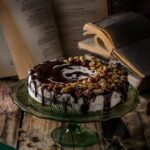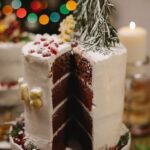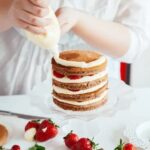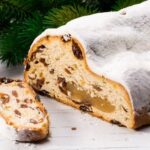Are you looking to elevate your baking skills and learn how to decorate buttercream cake like a pro? Decorating a buttercream cake is an art form that requires the right tools, techniques, and creativity.
In this article, we will guide you through the process of creating stunning designs and beautiful buttercream flowers that will impress any guest at your next event. From mastering piping techniques to troubleshooting common decorating issues, we have you covered with all the essential tips and tricks.
To begin with, understanding the essential tools and ingredients for decorating is crucial in achieving professional-looking results. We will explore the must-have items that every aspiring cake decorator should have in their arsenal. Additionally, we will provide insights on choosing the right type of buttercream for decorating purposes, as well as methods for preparing the cake to ensure a smooth canvas for your designs.
As we dive deeper into the art of buttercream cake decorating, we will provide step-by-step guidance on mastering piping techniques and creating intricate designs. You’ll also learn how to create stunning buttercream flowers that will add a touch of elegance to your cakes. Moreover, we will share valuable tips for achieving a smooth and flawless buttercream frosting finish while addressing common decorating issues that may arise.
So whether you are a beginner looking to improve your skills or an experienced baker seeking advanced techniques, this article has everything you need to become a master at decorating buttercream cakes. Let’s get started on this sweet journey of artistic expression through buttercream cake decoration.
Essential Tools and Ingredients for Decorating
When it comes to decorating a buttercream cake, having the right tools and ingredients is essential for achieving the perfect design. One of the most important tools for buttercream cake decorating is a good quality piping bag and piping tips. Piping bags come in various materials such as disposable plastic or reusable cloth, while piping tips come in different shapes and sizes for creating various designs and textures on the cake.
In addition to piping bags and tips, a good offset spatula is another essential tool for spreading and smoothing the buttercream frosting on the cake. This tool helps create an even layer of frosting and ensures a professional finish to the cake. Other important tools include a turntable for easily rotating the cake while decorating, as well as a bench scraper for achieving smooth edges and sides.
When it comes to ingredients, using high-quality butter, confectioners’ sugar, and pure vanilla extract is essential for making delicious and creamy buttercream frosting. It’s also important to have gel food coloring on hand to add vibrant colors to the frosting without altering its consistency. By having these essential tools and ingredients at your disposal, you’ll be well-equipped to create beautiful designs on your buttercream cake.
Choosing the Right Buttercream for Decorating
When it comes to decorating a buttercream cake, choosing the right type of buttercream is essential for achieving the perfect texture and consistency. There are several types of buttercream, including traditional American buttercream, Swiss meringue buttercream, and Italian meringue buttercream. Each type has its own unique qualities that make it suitable for different decorating techniques.
American Buttercream
American buttercream is the easiest and quickest to make, as it consists of only butter, powdered sugar, and flavorings. It has a sweet and creamy texture that makes it perfect for basic cake decorating techniques such as spreading and piping borders.
Swiss Meringue Buttercream
Swiss meringue buttercream is made by heating egg whites and sugar over a double boiler, then whipping them into a fluffy meringue before adding butter. This type of buttercream has a silky texture and is great for creating smooth finishes on cakes. It holds up well in warmer temperatures compared to American buttercream.
Italian Meringue Buttercream
Italian meringue buttercream involves making a hot sugar syrup that is poured into whipped egg whites to create a stable meringue. The addition of butter results in a rich and luxurious frosting that is perfect for intricate cake designs and decorations.
When choosing the right buttercream for decorating, consider the climate and the intended design of your cake. With the correct choice of buttercream, you can ensure that your cake not only looks beautiful but also tastes delicious.
Preparing the Cake for Decorating
To begin, it is important to make sure that the cake layers are level and even. This can be achieved by using a long serrated knife to carefully trim off any domed tops, creating a flat surface for decorating.
Once the cake layers are leveled, it is crucial to brush off any loose crumbs before applying a crumb coat of buttercream. The crumb coat will help seal in any loose crumbs and provide a smooth base for additional layers of frosting.
In addition to preparing the actual cake layers, it is important to choose a sturdy and stable surface for decorating. Whether using a cake stand or cardboard round, the base should be strong enough to support the weight of the finished cake. Once the cake has been placed on its decorating surface, it is ready to be layered with delicious buttercream frosting and decorative elements.
| Preparation Step | Description |
|---|---|
| Leveling Cake Layers | Using a serrated knife to level and trim any domed tops of the cake layers. |
| Crumb Coat Application | Applying a thin layer of buttercream frosting to seal in loose crumbs and create a smooth base. |
| Choosing Sturdy Base | Selecting a sturdy surface, such as a cake stand or cardboard round, for decorating. |
Mastering Piping Techniques
One of the key elements in decorating a buttercream cake is mastering piping techniques. Piping involves using a pastry bag or piping bag to create various designs, borders, and lettering on the cake. It may seem intimidating at first, but with practice and the right technique, you can achieve professional-looking results.
To master piping techniques, it’s important to have the right tools and materials. A good quality piping bag, a variety of tips in different shapes and sizes, and a sturdy coupler are essential for successful piping. Practice with different tips to see which ones work best for specific designs and textures.
Start by practicing basic piping techniques such as creating lines, dots, rosettes, shells, and swirls on a flat surface before moving on to decorating an actual cake. This will help you get comfortable with the pressure needed to pipe the buttercream and control the flow of frosting. Once you feel confident with the basics, you can move on to more intricate designs and decorations.
| Common Piping Tips | Description |
|---|---|
| Round Tip (3) | This tip is perfect for creating outlines, writing, dots or beads. |
| Star Tip (21) | Use this tip for making stars, flowers or shells. |
| Open Star Tip (1M) | Create large textured stars and rosettes with this tip. |
Creating Beautiful Buttercream Flowers and Designs
When it comes to decorating a buttercream cake, creating beautiful flowers and designs can take your creation to the next level. Whether you’re a beginner or an experienced baker, mastering the art of buttercream flowers and designs can add a stunning visual appeal to your cakes. Here are some tips and techniques for creating beautiful buttercream flowers and designs:
- Choose the right piping tips: The key to creating beautiful buttercream flowers and designs is using the right piping tips. For flower petals, a petal tip is essential, while a round tip can be used for creating various other designs.
- Practice pressure control: Achieving the perfect flower or design requires mastering the control of piping pressure. Practice applying different levels of pressure to create varied sizes and shapes of petals, leaves, and other decorative elements.
- Color blending: Experiment with blending different colors of buttercream to create multi-toned flowers and designs. Using a piping bag with two or more colors can result in stunning gradients and realistic floral effects.
Creating beautiful buttercream flowers and designs requires patience, practice, and attention to detail. With the right tools, techniques, and creativity, you can elevate your cake decorating skills to new heights.
Remember that practice makes perfect when it comes to mastering the art of buttercream flowers and designs. Don’t be discouraged by initial attempts-keep practicing, experimenting with different techniques, and incorporating your own unique style into your creations. With time and dedication, you’ll be able to create stunning buttercream masterpieces that will impress anyone who sees (and tastes) them.
Tips for Achieving Smooth Buttercream Frosting
Achieving smooth buttercream frosting is a crucial step in creating a beautifully decorated cake. Whether you are a beginner or an experienced baker, the following tips will help you achieve a flawless finish:
- Use the right consistency: The key to achieving smooth buttercream frosting is to ensure that it is the right consistency. If the frosting is too stiff, it will be difficult to spread and may result in uneven texture.
On the other hand, if the frosting is too soft, it may not hold its shape and can cause bulges or air bubbles. Aim for a medium consistency that is easy to spread but holds its shape when piped. - Crumb coat the cake: Before applying the final layer of buttercream frosting, it’s important to apply a thin layer called a crumb coat. This initial layer helps to lock in any loose crumbs and provides a smooth base for the final layer of frosting. Once the crumb coat has set, you can then proceed with applying the final layer of buttercream for a flawless finish.
- Use a bench scraper: A bench scraper is an essential tool for achieving smooth buttercream frosting. After applying the frosting to the cake, use a bench scraper to smooth out the surface and create clean edges. Hold the bench scraper at a 90-degree angle against the cake and spin the turntable as you gently press against the frosting to create a smooth finish.
By following these tips, you can achieve professional-looking smooth buttercream frosting on your cakes. Practice makes perfect, so don’t be discouraged if your first few attempts are not flawless – with time and patience, you’ll soon master this essential decorating skill.
Troubleshooting Common Buttercream Decorating Issues
Decorating a buttercream cake can be a fun and rewarding experience, but it doesn’t always come without its challenges. Despite your best efforts, you may encounter some common issues while decorating your cake with buttercream. Understanding how to troubleshoot these issues can help you achieve the perfect finish on your cake.
Problem: Buttercream Is Too Stiff or Too Soft
One of the most common issues when decorating with buttercream is getting the right consistency. If your buttercream is too stiff, it can be difficult to spread or pipe onto the cake smoothly. On the other hand, if it’s too soft, it may not hold its shape and could even melt in warm temperatures.
To troubleshoot this issue, adjust the consistency of your buttercream by adding more liquid (such as milk or cream) if it’s too stiff, or more powdered sugar if it’s too soft. Gradually add small amounts of either until you achieve the desired consistency.
Problem: Air Bubbles in Buttercream
Air bubbles can occur in buttercream when mixing it at high speed or from using a spatula to spread it onto the cake. These air bubbles can create an uneven finish when decorating. To fix this issue, use a paddle attachment on your mixer to mix the buttercream at low speed and avoid overmixing. You can also gently tap the filled piping bag on a flat surface to release any trapped air before piping.
Problem: Buttercream Crusting Too Quickly
If you’re trying to achieve smooth buttercream frosting or creating intricate designs, having the buttercream crust too quickly can be frustrating. To combat this issue, work in smaller sections when spreading or piping the frosting and use a small offset spatula to keep smoothing out any imperfections before they crust over completely. Additionally, you can try adding a small amount of corn syrup to your buttercream to slow down crusting.
By understanding how to troubleshoot these common buttercream decorating issues, you’ll be better equipped to handle any challenges that arise while creating beautiful designs on your cakes with this versatile frosting. Remember that practice makes perfect, and don’t be afraid to experiment with different techniques and adjustments until you achieve the desired result for your buttercream cake decoration project.
Advanced Buttercream Decoration Techniques
Once you have mastered the basics of buttercream cake decorating, you may want to explore advanced techniques to take your creations to the next level. One popular advanced technique is using a variety of piping tips to create intricate designs and textures on the cake. From ruffles and lace to basketweave and rosettes, different tips can be used to achieve stunning effects.
Another advanced technique is incorporating various colors into your buttercream decorations. This can be achieved by using different colored buttercream or by carefully blending colors together for a gradient effect. With practice, you can create beautiful ombre designs or even intricate multi-colored patterns on your cakes.
Additionally, experimenting with different textures and finishes can elevate your buttercream cake decorating skills. Consider trying techniques such as stenciling, painting with edible food coloring, or using edible glitter and pearls to add shimmer and sparkle to your creations. These advanced techniques can bring a unique and sophisticated touch to your buttercream cakes, making them truly stand out.
As you continue to hone your skills in advanced buttercream decoration techniques, don’t be afraid to push the boundaries of traditional cake decorating. Allow your creativity and imagination to guide you as you explore new ways to use buttercream as a medium for artistic expression on cakes. With dedication and practice, you can elevate your buttercream cake decorating from ordinary to extraordinary.
Conclusion and Final Tips for Perfect Buttercream Cake Decorating
In conclusion, mastering the art of buttercream cake decorating takes patience, practice, and the right tools and techniques. By choosing the right buttercream, preparing the cake properly, mastering piping techniques, creating beautiful designs, and achieving smooth frosting, you can create stunning and professional-looking cakes. Remember to troubleshoot common issues that may arise during decorating and continue to explore advanced techniques to take your skills to the next level.
To perfect your buttercream cake decorating, it’s essential to pay attention to detail and constantly strive for improvement. Don’t be afraid to experiment with new designs and techniques, as this will help you grow as a decorator. Additionally, seeking inspiration from other decorators and continually learning from tutorials or classes can provide you with fresh ideas and insights.
Finally, don’t forget that practice makes perfect. The more you work on your buttercream cake decorating skills, the better you will become. Whether it’s for personal enjoyment or professional purposes, creating beautifully decorated cakes can bring joy to both yourself and those who have the pleasure of enjoying your creations. Keep honing your skills, experimenting with new ideas, and most importantly – have fun with it.

Welcome to my blog about home and family. This blog is a place where I will share my thoughts, ideas, and experiences related to these important topics. I am a stay-at-home mom with two young children. I hope you enjoy reading it! and may find some helpful tips and ideas that will make your home and family life even better!





